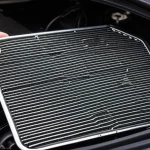Why Coastal Vehicles in the UK Are More Prone to Rust
Vehicles in the UK’s coastal regions face a higher rust risk due to several environmental factors. The coastal vehicle rust risk primarily stems from prolonged exposure to salt-laden air and high humidity typical of the UK coastal climate. Salt, carried by sea spray and airborne particles, accelerates the chemical process of rust formation by breaking down the protective layers on a vehicle’s metal surfaces. This makes coastal vehicles particularly vulnerable compared to those further inland.
Salt exposure facilitates oxidation, where iron reacts with oxygen and moisture to form iron oxide—commonly known as rust. In the UK coastal climate, this process is intensified by persistent dampness and temperature fluctuations, which allow moisture to remain on the surface longer. Common signs of rust on vehicles near the coast include bubbling paint, brown or orange flakes on wheel arches, door sills, and underneath the car.
Also to read : Master the track: expert advice for optimizing gear ratios in british race cars
Studies and maintenance data from UK coastal areas confirm a significantly higher rust prevalence in these zones. Preventative measures such as regular washing to remove salt deposits and applying anti-rust treatments can mitigate damage. Understanding these risks makes it easier to protect cars from the costly effects of corrosion in salt-heavy coastal environments.
Expert-Recommended Prevention Methods
Protecting your vehicle from rust is essential, especially in the UK where moisture and coastal environments accelerate corrosion. Rust prevention strategies focus on safeguarding vulnerable areas like underbodies and paintwork through professional treatments. These include the application of specialized anti-corrosion treatments such as wax coatings and rust inhibitors.
In the same genre : The definitive guide to brake fluids: best choices for high-performance british racing cars
Wax coatings form a protective layer that repels water and prevents salt and dirt from adhering, effectively reducing the risk of rust. Sealants complement this by filling microscopic surface gaps, creating a barrier against corrosive elements. For those near the coast, where salt exposure is higher, these treatments should be applied more frequently—ideally every 6 to 12 months to maintain optimal protection.
Experts emphasize that thorough preparation—cleaning and drying surfaces before application—maximizes product effectiveness. Regular inspections and timely touch-ups form part of the best vehicle protection UK practices, ensuring corrosion is detected early and managed proactively.
By integrating professional rust prevention strategies with routine maintenance, vehicle owners can significantly extend the lifespan of their cars and maintain resale value amid challenging UK weather conditions.
Regular Maintenance Routines for Coastal Vehicles
Keeping a coastal vehicle in top condition requires a thorough vehicle maintenance checklist tailored to the unique challenges posed by salty air and high humidity. Start with a regular washing routine that removes salt deposits. Use fresh water and mild car cleaning tips to rinse off grime, focusing on less visible areas like wheel arches, undercarriages, and door sills.
After washing, a detailed rust inspection UK practice becomes essential. Pay close attention to seams, bolts, and metal edges where corrosion often begins. Early rust detection hinges on examining these critical spots regularly to prevent costly damage.
Drying your vehicle thoroughly helps stop moisture from settling, which accelerates corrosion. Employing dedicated towels or air blowers is effective here. Integrate tools like wire brushes or rust converters to treat small rust spots immediately.
A comprehensive vehicle maintenance checklist for coastal use should include:
- Frequent washing using recommended car cleaning tips
- In-depth rust inspection UK routines focusing on vulnerable points
- Prompt drying and application of protective sprays
Following these steps consistently prevents deterioration and prolongs your vehicle’s lifespan in harsh coastal environments.
Legal and MOT Considerations for Rust in the UK
Understanding the impact of rust on vehicle compliance
Rust is a critical factor in MOT rust requirements within the UK. For vehicles, especially those frequently exposed to coastal environments, rust can compromise essential components, influencing UK vehicle safety standards. The MOT test specifically inspects for corrosion that affects the structural integrity or safety systems such as brakes, seatbelts, and suspension. If rust is severe enough to impair these systems, the vehicle may fail its MOT.
According to UK regulations, rust that damages critical parts is not merely an advisory issue but a legal concern. The Vehicle and Equipment Regulations require vehicles to be free from corrosion that could impair safety. Rust that causes holes in load-bearing sections or weakens mounting points can lead to immediate MOT failure.
To navigate these rules effectively, maintaining thorough documentation of any rust-related repairs or advisories is essential. MOT certificates may highlight rust as an advisory if not severe, but ignoring these warnings risks legal implications and roadworthiness concerns. Addressing rust promptly ensures compliance with legal rust implications and enhances vehicle longevity and safety on UK roads.
Real-World Examples and Actionable Checklists
Coastal conditions in the UK often accelerate rust formation. Drivers based near the sea share vital insights on protecting their vehicles.
One UK driver explains, “Living steps from the shore means salt spray is a constant issue. I make washing my car after beach trips non-negotiable.” Such case studies highlight the importance of timely maintenance. Another testimony stresses undercarriage checks every two months, a practice that has saved them costly repairs.
A practical rust prevention checklist for UK drivers in coastal areas should include:
- Frequent washing, focusing on wheel arches and underside to remove salt residue.
- Applying rustproof sealant annually to vulnerable spots.
- Regularly inspecting drains and seals to avoid water accumulation.
These steps form a solid foundation for long-term vehicle care. Coastal drivers note even small efforts significantly delay rust onset. This real-world evidence proves preventive routines improve vehicle resilience.
Combining firsthand experiences with a focused checklist empowers UK drivers to address rust proactively and extend vehicle lifespan despite challenging environments.


